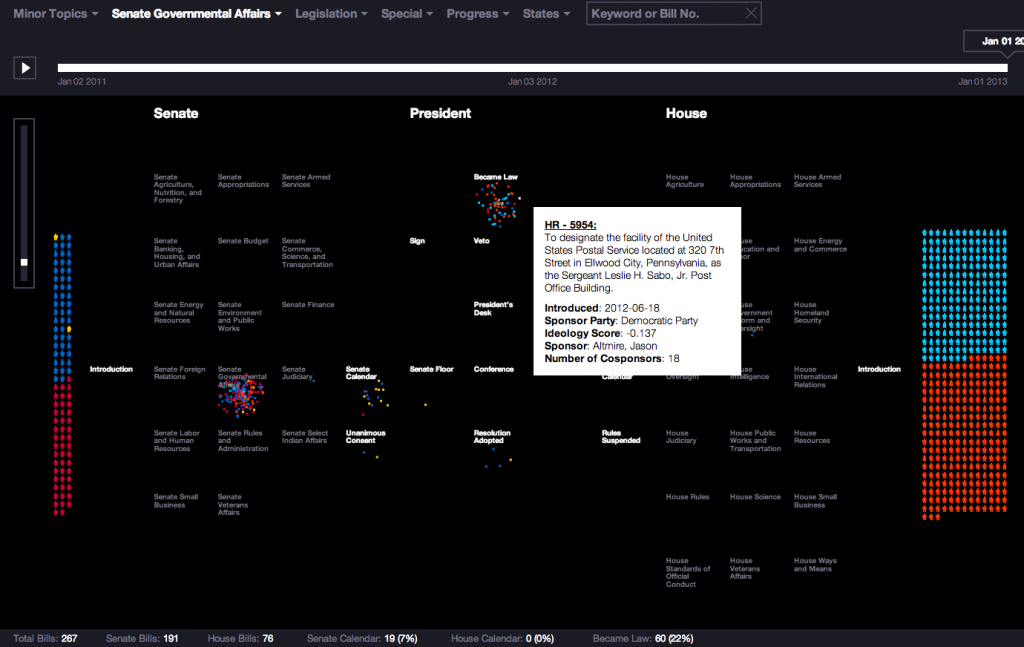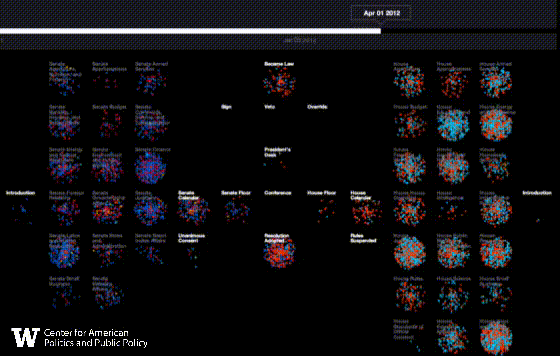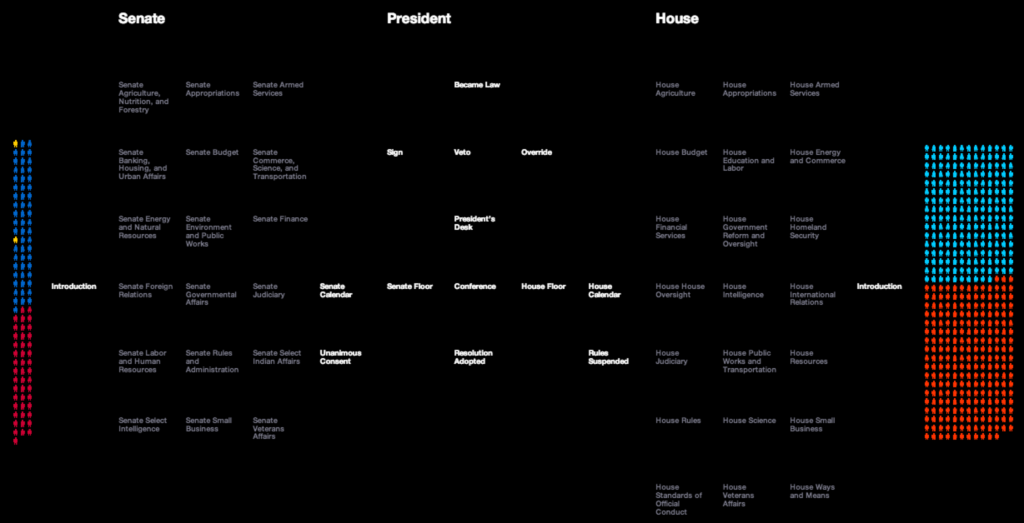We have been very pleased by the positive response to LegEx from people around the world and by the many k-12 and college level instructors who use it in their classes.
Category Archives: LegEx
The end of School House Rock?
Of course not, but we think resources like Legislative Explorer shed new light on an obscure process that has benefits for students, the public, and even researchers.
Legislative Explorer lets users explore the lawmaking process. One of the things that we hope will emerge from these explorations is an appreciation of the Congress as an institution – how it is organized, its responsibilities, and the issues it considers.
Data-driven discovery tools were specifically developed to help natural science researchers explore and make sense of complex data. Tools like Legislative Explorer show that it is possible to leverage the same benefits to promote a richer, subtler form of civics education.
LegEx is a collaboration between the Center for American Politics and Public Policy at the University of Washington (John Wilkerson and Nicholas Stramp) and Schema (Christian Marc Schmidt and Sergei Larionov), a creative design and technology studio in Seattle. Both Wilkerson and Stramp have backgrounds in K-12 education. Wilkerson developed LegSim, an interactive legislative simulation for high school and college students. Stramp taught middle school math and science before joining the UW. Wilkerson provided the initial vision for the project; Stramp wrangled the extensive underlying data. Schmidt and Larionov converted the vision and data into a polished project using the power of HTML5 and javascript.
For more information, contact:
John Wilkerson (jwilker@uw.edu)
Why do bills progress?
Another perspective is to limit attention to bills referred to a particular committee or committees (using available filters). This helps to underscore how the progress of bills often has little to do with a sponsor’s efforts and abilities. Compare, for example, the progress of bills referred to the two tax committees (below).
In the House, referring bills to multiple committees at once is a fairly common practice, giving the Ways and Means committee broad influence because so many bills have revenue implications. The Senate process is strikingly different. There is no multiple referral in the Senate so the Finance committee does not have jurisdiction over bills referred to other committees.
But the most striking differences are the success rates for bills referred to these two committees. Only one bill under the jurisdiction of the Senate Finance committee became law (The Protect our Kids Act of 2012), compared to 17 bills in key areas such as free trade, tax relief, and more, for House Ways and Means.
Why was the Republican-controlled House seemingly so much more influential in this issue area when the Senate was controlled by the same party as the presidency? The answer is rooted in the Constitution, which specifies that “All Bills for raising Revenue shall originate in the House of Representatives.” Senate sponsors are doomed to failure where bills that involve raising revenue are concerned (a substantial proportion of all important legislation, including the Dodd-Frank Wall Street Reform and Consumer Protection Act and the Patient Protection and Affordable Care Act).
Another perspective is to examine committee success rates. Which committee’s bills were most likely to become law? Of the 284 bills that became law in the 112th Congress, sixty fell under the jurisdiction of the Senate Governmental Affairs committee. This committee’s bills has an impressive 22% success rate compared to an overall success rate of just 2%. However, clicking on some of these bills reveals a pattern that is less impressive. Most of these laws named federal buildings, while the remainder were specific to the federal government’s District of Columbia oversight responsibilities.
Next: The end of School House Rock?
Why do legislators sponsor bills?
The previous comparison of the 102nd and 112th also reveals differing patterns of lawmaking activity. One of the lessons that emerges from exploring these differences is that members sponsor bills for many different reasons. The visible bursts and lulls in activity are often explained by predictable events (such as the beginning and end of sessions or congressional recesses). However, others are more intriguing.
Over the course of a couple of days in 102nd Congress (late March of the second session), dozens of Republican-sponsored (red) bills were referred to the Senate and House Appropriation committees (the middle committee in the top row of each chamber). Clicking on some of these bills revealed that all were introduced by just two lawmakers, Senator John McCain and Rep. Fawell Harris. What’s going on here? In this case, action by the President helps to explain action by lawmakers. All of the bills sought to force the Democratic Congress to vote separately in favor of “pork barrel” projects if it wanted to restore funding that President Bush had recently rescinded (Feldman an Perotti 2002).
 There were even larger bursts of activity during the second session of the 112th Congress (April) as hundreds of bills were referred to the Senate Finance and House Ways and Means committees over about a week. Clicking on some of these bills revealed that they were all tariff-related. The explanation in this case is that members were introducing bills in response to an internal process. The Finance and Ways and Means chairs announced they would be drafting an omnibus “Miscellaneous Tariff Bill (MTB)” later in the year. They invited members to propose specific tariff provisions in the form of bills. The bursts reflects the fact that most members introduced their bills just prior to the announced deadline.
There were even larger bursts of activity during the second session of the 112th Congress (April) as hundreds of bills were referred to the Senate Finance and House Ways and Means committees over about a week. Clicking on some of these bills revealed that they were all tariff-related. The explanation in this case is that members were introducing bills in response to an internal process. The Finance and Ways and Means chairs announced they would be drafting an omnibus “Miscellaneous Tariff Bill (MTB)” later in the year. They invited members to propose specific tariff provisions in the form of bills. The bursts reflects the fact that most members introduced their bills just prior to the announced deadline.
Next: Why do bills progress?
Our dysfunctional Congress
It is generally widely accepted that recent Congresses have more contentious and less productive than in the past. What does dysfunction look like from the perspective of patterns of bill activity?
The visualization below contrasts the last Congress (112th, 2011-12) to a Congress from two decades ago (102nd, 1991-92) when George H.W. Bush was President and Congress was controlled by Democrats. There are many possible explanations for why more recent Congresses might be less productive. One of the patterns that emerges from the visualization is that an important bottleneck happens late in the process.
In the 102nd, there is a fairly steady stream of bills moving from the House and Senate floors to the President’s desk and into law. In the 112th, the pattern is more like a dripping faucet. Of the bills that passed the House and Senate, 22.6% became law compared to just 14.5% for the 112th. Overall, the 102nd Congress passed 2.5 times more bills than the 112th.
Next: Why do legislators sponsor bills?
Visualizing Lawmaking: The End of School House Rock?
Most of us learned (in school or by watching School House Rock) that members of Congress dream up solutions to problems in society, introduce them as bills and then struggle to advance those bills through a maze of procedural hurdles to become law. Of course, this civics portrayal of lawmaking vastly oversimplifies the legislative process, but what’s the alternative?
Researchers at the University of Washington’s Center for American Politics and Public Policy are applying data-driven discovery methods popular in the natural sciences to visualize and learn about lawmaking. Legislative Explorer, or LegEx, visually traces the progress bills and resolutions as they move through Congress.
The image below is a spatial representation of the congressional lawmaking process. The left half represents the U.S. Senate, with senators sorted by party (blue=Democrat) and a proxy for ideology (top=liberal). The House is displayed on the right. Moving in from the borders, the standing committees of the Senate and House are represented, followed by the Senate and House floors. A bill approved by both chambers then moves upward to the President’s desk and into law, while an adopted resolutions (that does not require the president’s signature) moves downward.
The progress of one important bill, the Dodd-Frank Wall Street Reform and Consumer Protection Act of 2010, is captured in the following animation. The bill (represented by a blue particle) was introduced by House Financial Services Committee chairman Barney Frank (D-MA) on December 2, 2009, and simultaneously referred to several House committees. After passing the House on Dec. 11, it was referred to just one Senate Committee (Banking, Housing and Urban Affairs) chaired by Christopher Dodd (D-CT). The bill was then passed by the Senate on May 20 before ‘ping ponging’ back and forth between the chambers as a conference committee resolved the differences. On July 21 the President signed the bill into law.
The next animation captures the progress of all bills and resolutions introduced in the current 113th Congress (about 8,000 to date). The different colors of the particles indicates the party and chamber of the bill or resolution’s sponsor. Democrats are blue, Republicans red. Lighter shades of blue and red are bills or resolution sponsored by House members.






